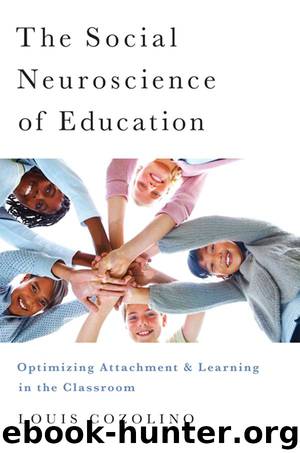The Social Neuroscience of Education: Optimizing Attachment and Learning in the Classroom (Norton Books in Education) by Cozolino Louis

Author:Cozolino, Louis [Cozolino, Louis]
Language: eng
Format: epub
Publisher: W. W. Norton & Company
Published: 2013-01-07T00:00:00+00:00
Teaching about the interconnections among the brain, the body, and how we learn will provide students with important scientific knowledge, which could improve their academic performance and physical health.
7. Sleeping Is Vital to Learning
Sleep is the golden thread that ties health and our bodies together.
—Thomas Dekker
Sound and sufficient sleep is particularly important for learning and memory (Curcio et al., 2006; Medeiros et al., 2001; Perez-Chada et al., 2007; Walker et al., 2002). Sleep boosts cognitive performance and augments learning while sleep deprivation limits our ability to sustain vigilance and attention (Doran et al., 2001; Lim & Dinges, 2008). There is considerable evidence that dreaming involves the rehearsal and consolidation of recent learning into long-term memory while naps that include slow wave and REM sleep improve perceptual skills (Mednick et al., 2003).
Sleep deprivation has been shown to impair flexible thinking and decision-making involving innovation, revising plans, and effective communication (Curcio et al., 2006; Harrison & Horne, 1999, 2000). In fact, the more complex the subject matter, the more helpful sleep is (Peigneux et al., 2001). Table 14.3 includes some suggestions for better sleep that may be helpful for both teachers and students.
Contrary to popular belief, adolescents need almost as much sleep (9.25 hours) as children (10 hours), although the average teenager gets only between 6.5–7.5 hours. Between 1974 and 1993, total sleep time for adolescents decreased because of later bedtimes but unchanged waking hours (Iglowstein et al., 2003). Most teenagers try to “catch up” on their sleep on weekends, which serves only to further disturb their biological rhythms. Modeling on their parents, they also become dependent on hypercaffeinated “power drinks” to get them through the day.
Download
This site does not store any files on its server. We only index and link to content provided by other sites. Please contact the content providers to delete copyright contents if any and email us, we'll remove relevant links or contents immediately.
| Administration | Assessment |
| Educational Psychology | Experimental Methods |
| History | Language Experience Approach |
| Philosophy & Social Aspects | Reform & Policy |
| Research |
The Art of Coaching Workbook by Elena Aguilar(50880)
Trainspotting by Irvine Welsh(21490)
Twilight of the Idols With the Antichrist and Ecce Homo by Friedrich Nietzsche(18480)
Fangirl by Rainbow Rowell(9073)
Periodization Training for Sports by Tudor Bompa(8145)
Change Your Questions, Change Your Life by Marilee Adams(7614)
This Is How You Lose Her by Junot Diaz(6762)
Asking the Right Questions: A Guide to Critical Thinking by M. Neil Browne & Stuart M. Keeley(5607)
Grit by Angela Duckworth(5497)
Red Sparrow by Jason Matthews(5371)
Paper Towns by Green John(5069)
Room 212 by Kate Stewart(5016)
Ken Follett - World without end by Ken Follett(4623)
Housekeeping by Marilynne Robinson(4307)
The Sports Rules Book by Human Kinetics(4273)
Double Down (Diary of a Wimpy Kid Book 11) by Jeff Kinney(4187)
Papillon (English) by Henri Charrière(4179)
The Motorcycle Diaries by Ernesto Che Guevara(3992)
Exercise Technique Manual for Resistance Training by National Strength & Conditioning Association(3939)
